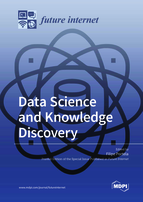Data Science and Knowledge Discovery
A special issue of Future Internet (ISSN 1999-5903). This special issue belongs to the section "Big Data and Augmented Intelligence".
Deadline for manuscript submissions: closed (31 January 2021) | Viewed by 68934
Special Issue Editor
2. IOTECH—Innovation on Technology, 4785-588 Trofa, Portugal
Interests: knowledge discovery; data science; progressive web apps; research and development
Special Issues, Collections and Topics in MDPI journals
Special Issue Information
Dear Colleagues,
The importance and impact of data science (DS) in the decision process are significantly increasing. DS is an interdisciplinary field that combines a set of areas including computer science, machine learning, math and statistics, domain/business knowledge, software development, and traditional research. As a research topic, DS applies scientific methods, processes, algorithms and systems to extract knowledge and insights from structured and unstructured data.
Knowledge discovery (KD) is the basis of data science and consists of the creation of knowledge from structured and unstructured sources (e.g., text, data, and images, among others). The output needs to be in a readable and interpretable format. It must represent knowledge in a manner that facilitates inferencing.
Several areas, like education, health, accounting, energy, and public administration are exploring this new trend. In this context, this Special Issue provides an excellent opportunity for providing scientific knowledge and disseminating the findings and achievements through several communities.
This Special Issue will discuss this trending topic and present innovative solutions to show the importance of data science and knowledge discovery to researchers, managers, industry, society, and other communities.
Finally, I would like to thank Gisela Fernandes and her valuable work for assisting me with this Special Issue.
Prof. Dr. Filipe Portela
Guest Editor
Manuscript Submission Information
Manuscripts should be submitted online at www.mdpi.com by registering and logging in to this website. Once you are registered, click here to go to the submission form. Manuscripts can be submitted until the deadline. All submissions that pass pre-check are peer-reviewed. Accepted papers will be published continuously in the journal (as soon as accepted) and will be listed together on the special issue website. Research articles, review articles as well as short communications are invited. For planned papers, a title and short abstract (about 100 words) can be sent to the Editorial Office for announcement on this website.
Submitted manuscripts should not have been published previously, nor be under consideration for publication elsewhere (except conference proceedings papers). All manuscripts are thoroughly refereed through a single-blind peer-review process. A guide for authors and other relevant information for submission of manuscripts is available on the Instructions for Authors page. Future Internet is an international peer-reviewed open access monthly journal published by MDPI.
Please visit the Instructions for Authors page before submitting a manuscript. The Article Processing Charge (APC) for publication in this open access journal is 1600 CHF (Swiss Francs). Submitted papers should be well formatted and use good English. Authors may use MDPI's English editing service prior to publication or during author revisions.
Keywords
- data mining
- big data
- machine learning
- text mining
- applied data science
- image mining
- business intelligence
- artificial intelligence
- intelligent data systems
- expert systems
- business intelligence
Related Special Issue
- Trends of Data Science and Knowledge Discovery in Future Internet (25 articles)






